
Desk of contents
Coloration replica on shows is a considerably difficult topic, however it’s value exploring should you care about picture high quality. If you happen to’ve ever checked out a sampling of televisions subsequent to one another at an electronics retailer, you might have realized that all of them look a bit completely different. Even should you choose the identical picture, completely different shows simply are likely to course of and output colours in a different way.
That is the place coloration gamut — or the show’s coloration palette — comes into play.
What’s a coloration gamut?

Calvin Wankhede / Android Authority
Usually phrases, the phrase coloration gamut merely refers to the entire colours our eyes can understand. It’s generally represented by a horseshoe-shaped determine — referred to as the xy chromaticity diagram (proven under). There’s additionally a three-dimensional illustration, however that’s a technicality we don’t want to fret about.
Within the laptop graphics trade, nonetheless, gamut normally signifies a show’s coloration dealing with capabilities. Merely put, it’s a measure of the colours a given show can reproduce.
Understanding a show’s coloration gamut is sufficient to offer you some indication of its coloration dealing with capabilities.
Show coloration gamuts are a subset of the xy chromaticity diagram — virtually all the time within the form of a triangle. In different phrases, shows can solely output a fraction of all seen colours. sRGB, the most typical show coloration gamut in use at present, is highlighted within the following diagram. An sRGB show merely can’t reproduce any coloration that lies exterior of the triangle.

The sRGB coloration gamut
A bigger triangular space signifies that the show’s gamut covers a better share of the seen spectrum. And as you’d anticipate, the bigger the overlap between a show’s coloration gamut and what our eyes can distinguish, the higher.
No client show in the marketplace proper now can cowl our whole visible spectrum. However that’s not an issue as such.
A phrase on bit-depth
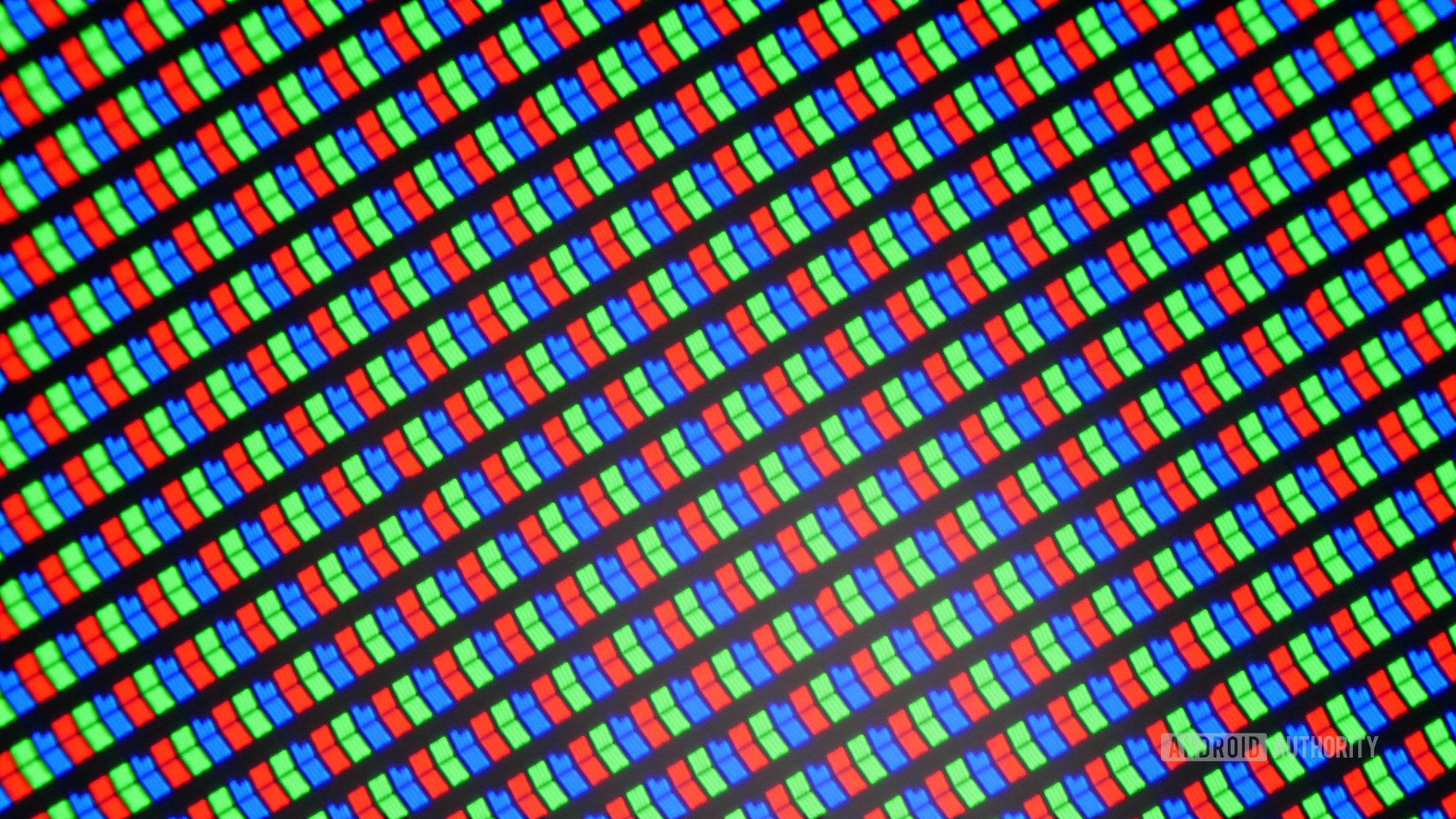
Earlier than we are able to discuss concerning the various kinds of coloration gamuts, it’s value understanding how shows produce colours within the first place. In a nutshell, nearly all shows are made up of tiny pink, inexperienced, and blue sub-pixels that mix to output a desired coloration. These sub-pixels are invisible to our eyes, however you’ll be able to see them fairly clearly beneath a microscope.
To that finish, a large coloration gamut isn’t the one standards crucial for a picture to look good. Shows should even be able to producing distinctive pink, inexperienced, and blue shades inside their restricted gamut.
We use bit-depth to measure the variety of distinctive shades a show can produce. Put merely, it’s the quantity of knowledge used to point the brightness stage of every sub-pixel.
The next bit-depth ensures that the show can precisely output delicate transitions or gradients between colours.
A show with a bit-depth of 8 bits will produce 28 or 256 shades of every major coloration (pink, inexperienced, and blue). Mixed, that offers you 16.7 million attainable coloration mixtures. A ten-bit show, alternatively, can output 1,024 shades or a cumulative 1.07 billion colours.

The next bit-depth ensures that the show can precisely output delicate transitions or gradients between colours. That is just because the show has extra “steps” in between comparable colours. In any other case, you observe an impact generally generally known as banding, which visually appears like well-demarcated gradations between comparable colours. That is much more vital for wide-gamut shows. An exaggerated rendition of that is highlighted within the above illustration.
Now that we’ve bought the technical definitions out of the best way, let’s discuss concerning the 4 most distinguished coloration gamuts in use at present.
sRGB defined
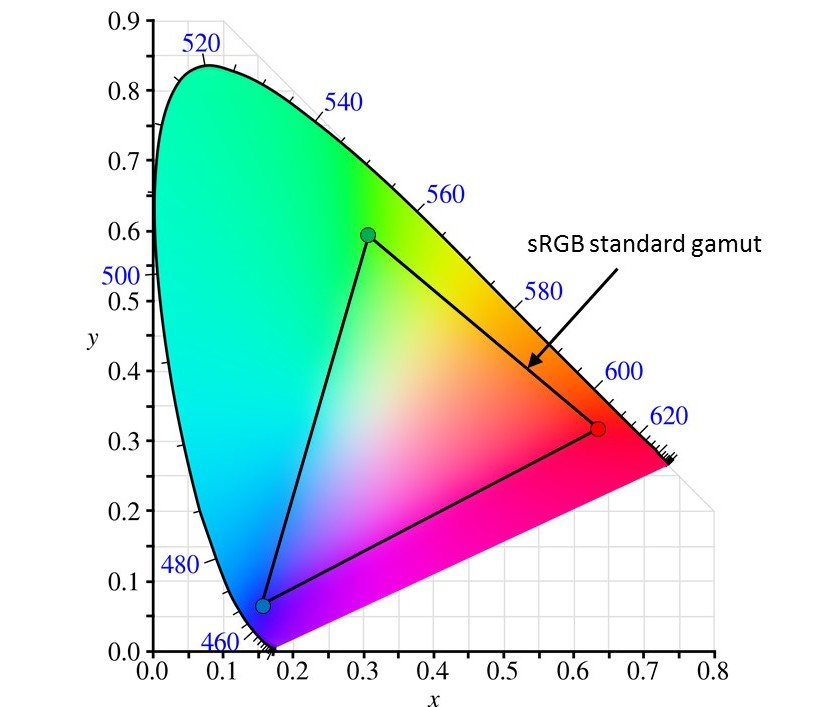
sRGB, or commonplace RGB, is the oldest however nonetheless essentially the most generally used coloration area. It was initially designed by the Worldwide Electrotechnical Fee (IEC) within the Nineties for CRT shows. Since then, it has been tailored for LCDs and different show applied sciences as nicely.
Whereas well-liked, sRGB solely covers a fraction of the seen gentle spectrum. Put merely, an sRGB show can reproduce 25 to 33% of the colours our eyes can understand. Wanting on the chromaticity diagram, it’s instantly obvious that we’re lacking a variety of the outer sections of every major coloration.
Whereas sRGB features a vary of pink, inexperienced, and blue shades, it doesn’t cowl the extra saturated sections. That is very true should you take a look at the inexperienced space. Naturally, this reduces the so-called vividness of the picture, making colours look a bit extra muted than they maybe would in actual life.
Whereas sRGB features a vary of pink, inexperienced, and blue shades, it doesn’t cowl the extra saturated sections.
sRGB is intently associated to the Rec. 709 gamut. In truth, the 2 requirements cowl the identical space of the chromaticity diagram. The one distinction is that sRGB makes use of a decrease gamma worth than Rec. 709.
sRGB’s decrease gamma facilitates higher coloration notion in brighter rooms akin to an workplace area. Rec. 709, alternatively, was designed for televisions and assumes that the show is considered in dimly lit environments. Since most shows let you tweak the gamma your self, the excellence between sRGB and Rec. 709 is basically irrelevant.
Regardless of its restricted coloration protection, sRGB has grow to be the dominant commonplace for shows of all styles and sizes. Most PC working programs, together with Home windows, are tuned for sRGB out of the field. Equally, most web sites and content material are additionally designed with sRGB in thoughts.
AdobeRGB: designed for pictures
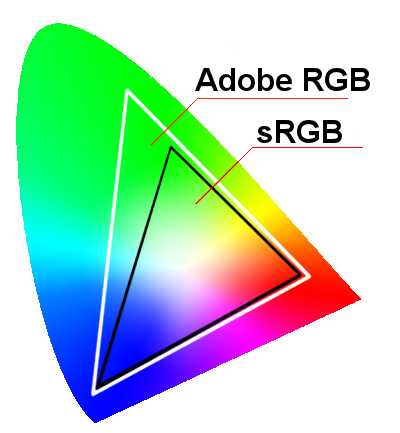
As you might have guessed, the AdobeRGB coloration area was developed and popularized by software program large Adobe. It’s a wider gamut than sRGB, masking roughly 50% of the seen coloration spectrum.
In contrast to most different coloration areas on this record, AdobeRGB is just not used for video in any respect. As an alternative, it was designed particularly for images. To grasp why, we’ll need to shift our focus to paint printers. You will have seen that printers don’t mix pink, inexperienced, and blue (RGB) ink to provide coloration prints.
Learn extra: Adobe Lightroom tips for improving your phone’s photos
As an alternative, most coloration (and picture) printing tools makes use of the CMYK (cyan, magenta, yellow, and black) coloration mannequin. In 1998, Adobe developed AdobeRGB to cowl this coloration area and supply photographers with extra management over their prints. In impact, AdobeRGB expands sRGB’s restricted protection of cyan and inexperienced hues — instantly obvious should you take a look at the chromaticity diagram.
Whereas AdobeRGB is undoubtedly helpful for images, most cameras nonetheless default to the sRGB coloration area. It is because most pictures are considered digitally, on screens which are restricted to the sRGB gamut. Moreover, even on appropriate shows, most applications can’t output AdobeRGB.
AdobeRGB has restricted utility at present as a result of it was designed to imitate the colour area utilized by picture printers.
If a web site consists of an AdobeRGB file, for instance, net browsers will mechanically try to render it in sRGB as an alternative. Nevertheless, this conversion course of is just not good and the result’s typically considerably worse-looking than an sRGB picture.
In abstract, dealing with AdobeRGB content material requires the usage of photo-specific software program and instruments. If the file is dealt with improperly at any level, you may find yourself with an inferior sRGB picture. All of this, coupled with low client demand through the years, signifies that AdobeRGB is a distinct segment coloration gamut at present. Nonetheless, some high-end screens supply a devoted image profile that’s calibrated particularly for this use case.
DCI-P3

Digital Cinema Initiatives — Protocol 3, generally shortened to DCI-P3, was developed by the cinema trade to switch sRGB.
DCI-P3 covers a 25% bigger space of the chromaticity diagram, a determine that’s fairly just like AdobeRGB. Versus AdobeRGB’s green-cyan bias, nonetheless, P3’s features are extra evenly unfold out throughout all three major colours. In observe, which means DCI-P3 shows can output extra saturated and vivid colours throughout the board.
Since DCI-P3 was developed to be used over a digital medium, it has seen a lot wider adoption than AdobeRGB. Virtually each single gadget sort, from televisions to smartphones, now goals for not less than some protection of this coloration area, with higher-end shows providing round or above 90% protection.
DCI-P3 has grow to be more and more well-liked over the previous few years, and is taken into account the baseline for a superb HDR show.
As with all coloration gamuts, take into account that you additionally want content material mastered for DCI-P3 to understand the total extent of its vary. If you happen to view a picture that was mastered for sRGB, you’ll get far more saturated colours on a DCI-P3 show than the creator in all probability meant.
Rec. 2020 and Rec. 2100

Rec. 2020 and 2100 are the most recent gamuts on this record. Apart from masking the most important space on the chromaticity diagram, Rec. 2020 additionally helped outline the UHDTV (extremely excessive definition tv) commonplace. In a nutshell, it was the primary commonplace to incorporate assist for 10 and 12-bit shows alongside larger resolutions akin to 4K and 8K. The specification additionally lists assist for larger than 60Hz refresh charges, topping out at 120Hz.
The Rec. 2020 gamut covers a powerful 75% of the seen gentle spectrum. That’s a virtually 40% bounce from DCI P3 and an much more important leap from sRGB.
In truth, the colour gamut is so large that even one of the best client shows can solely cowl round 60 to 80% of it. Developments in microLED and quantum dot show applied sciences, nonetheless, will seemingly enhance their coloration replica capabilities in the long run.
The Rec. 2020 gamut covers a powerful 75% of the seen gentle spectrum, however most shows cannot supply full protection but.
Rec. 2100, alternatively, is an growth of Rec. 2020. It leaves most parameters unchanged from Rec. 2020, together with the colour protection. The one factor it provides is assist for prime dynamic vary (HDR) by way of two methods: hybrid log gamma (HLG) and perceptual quantization. The latter varieties the idea of frequent HDR codecs like HDR10 and Dolby Imaginative and prescient. HLG, alternatively, is solely used for broadcast tv.
Past coloration: Coloration errors and white level
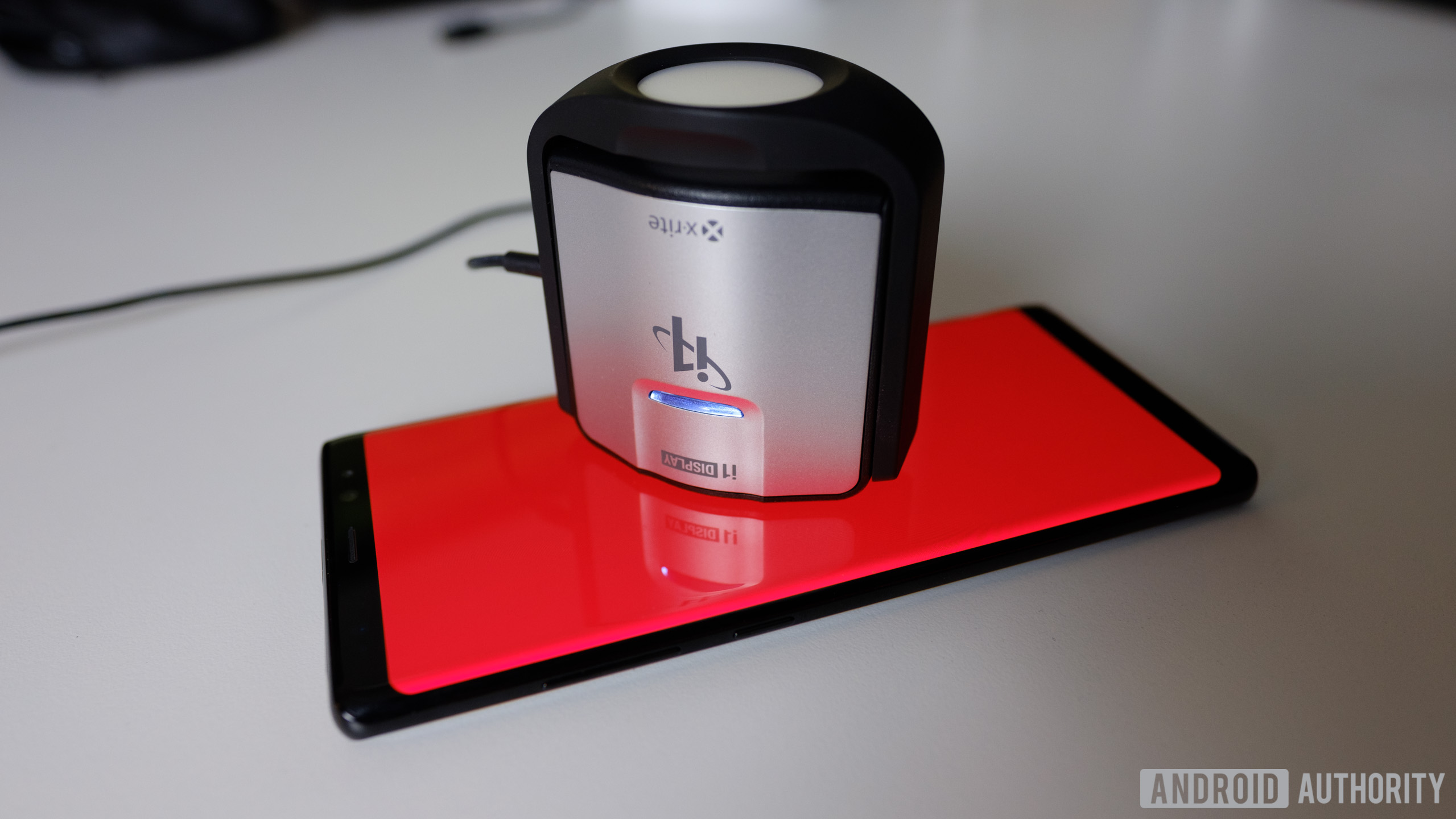
Setting every telephone’s display to 200cd/m^2 permits us to check every telephone’s efficiency immediately.
Whereas a large coloration gamut is definitely fascinating, it’s not the one issue that determines how nicely a given show will carry out. We’ve already spoken at size about how gamma and bit-depth affect the general perceived picture.
In that vein, no two shows ever look the identical, even when they boast almost equivalent coloration gamuts. That’s as a result of there are a few different vital metrics that may result in variances in a show’s coloration rendering functionality. You usually received’t discover these attributes represented on most show spec sheets. Apart from the show’s gamut protection, we additionally want to take a look at two extra metrics, specifically Delta E and coloration temperature.
See Additionally: How we test displays at Android Authority
Delta E

You may consider Delta E as a approach to measure the error in a show’s coloration output. What does an error appear to be in sensible phrases? A show that makes reds appear to be darkish orange, for instance.
Extra particularly, although, Delta E measures the distinction between a show’s coloration output versus the usual gamuts like sRGB.
The above graph, for example, reveals our benchmark of the OnePlus 8 Professional’s show in opposition to the sRGB commonplace. The outcome signifies that the show is well-calibrated in most areas, aside from a few offshoots within the red-yellow sections. The common Delta E (or the distinction between output and reference) on this case was roughly 2.8.
For context, a Delta E worth under one represents an imperceptible error, not less than to the human eye. Professionals that use calibrated shows are likely to favor a most Delta E of two.0. Any larger than that and the shift in coloration accuracy rapidly turns into obvious.
Coloration temperature

White level, additionally generally generally known as coloration temperature, has an outsized affect on the looks of whites on a show. The above picture, for instance, reveals what “white” appears like on completely different smartphone shows.
We usually measure coloration temperature in Kelvin and also you’ll discover values usually lie within the vary of 4,000 to 7,000K. Why Kelvin after we’re not speaking a few show’s precise temperature? As a result of the size corresponds to the colour of sunshine radiated from a sizzling, glowing steel object. Consider a fuel flame — you see reddish yellow hues at one excessive and bluish tones on the different. In shows, we seek advice from whites with a blue forged as having a “cooler” look and vice-versa.
Coloration requirements usually anticipate shows to have a white level of 6,500K, also called D65. For some context, the colour temperature of daylight lies someplace between 5,000 and 6,000 Kelvin.
Most coloration gamuts are designed across the D65 white level, or 6,500 Kelvin.
If both the white level or Delta E values are off by a major margin, it could be attainable to recalibrate the show. In truth, even high-end shows that ship correctly calibrated from the manufacturing facility can expertise drift after lengthy durations of time. The instruments wanted to perform this, nonetheless, will not be low cost. And except you’re a artistic skilled, you’re unlikely to note or care a few small error anyway.
Why are large coloration gamuts instantly gaining momentum?
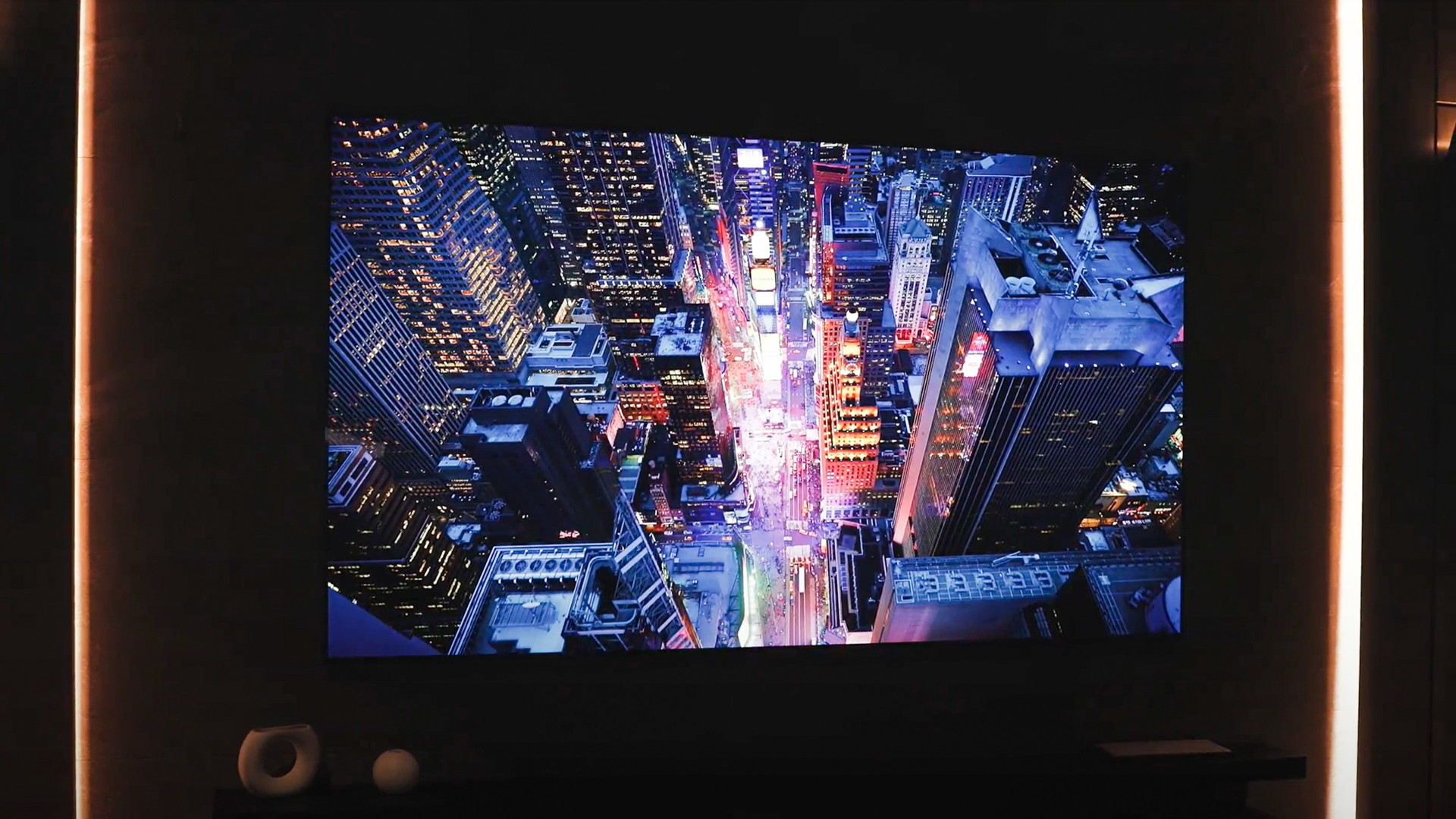
Our eyes have grow to be quite accustomed to the slim sRGB gamut over the previous few a long time. Nevertheless, that’s solely as a result of, till lately, only a handful of shows featured wider coloration gamuts. These typically value a reasonably premium too — so solely artistic professionals might justify selecting one up. That’s not true at present, although.
The show trade has lastly progressed to the purpose the place mass-produced panels with large coloration gamuts have grow to be reasonably priced. Concurrently, developments in digicam know-how have made it simpler than ever for filmmakers to seize further coloration element. Mixed, these two elements have made gamuts like DCI-P3 extraordinarily accessible and reasonably priced.
Many mid-range and flagship smartphones today attempt to supply good protection of the DCI-P3 coloration area. Some flagships, like Sony’s Xperia 1 collection and the iPhone 13, will even file footage in a wider coloration gamut. Equally, televisions and laptop screens are lastly transferring previous sRGB as nicely. On the software program facet of issues, main desktop and cellular working programs additionally now assist coloration areas past sRGB.
Many mid-range and flagship smartphones today supply good protection of the DCI-P3 coloration area, as do televisions and screens.
The content material trade’s push for HDR has additional helped drive demand for wider coloration areas. Certainly, you’ll discover that the majority content material — from video video games to TV reveals — is out there in a wider coloration gamut than sRGB. To that finish, HDR sources akin to gaming consoles, video streaming companies, and even broadcast televisions at the moment are available. Even net design requirements like CSS are beginning to embody assist for Show-P3 (Apple’s implementation of DCI-P3).
In a nutshell, HDR goals to make pictures look extra lifelike and life like. As you’d anticipate, delivering a extra vivid coloration palette helps to attain that aim. Most HDR codecs, together with Dolby Imaginative and prescient and HDR10+, mandate that shows and content material cowl the DCI-P3 coloration area at a minimal.
See additionally: Here’s how to stream Netflix movies and shows in HDR
The show trade can also be aiming for full protection of the extra expansive Rec. 2020 coloration area in some unspecified time in the future sooner or later. Whereas no client product delivers a coloration gamut that large at present, it’s solely a matter of time earlier than that modifications.

